In this interview, we sit down with Raimonds Selga, co-founder and board member of Kalve Coffee, a fast-growing specialty coffee brand based inLatvi ...
How Keri Hissim Turned Mushrooms into Culinary Gold
Written by: Esther Strauss
Esther is a business strategist with over 20 years of experience as an entrepreneur, executive, educator, and management advisor.
Published on March 18, 2024
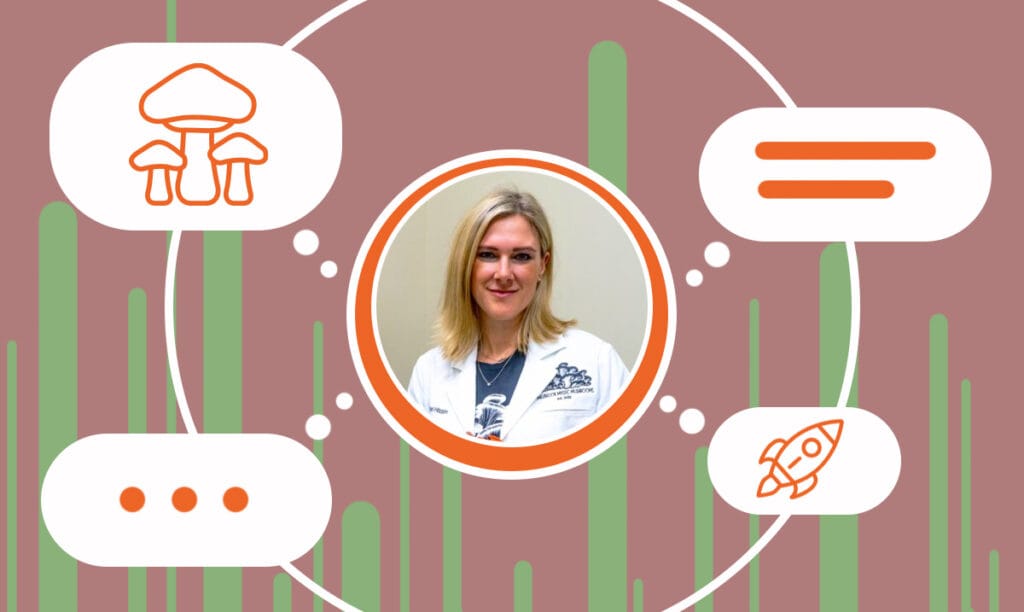
In this interview, we sit down with Keri Hissim, the innovative founder behind Millbrook Mushrooms. Diving into the earthy world of gourmet mushrooms, Keri shares her journey from a spark of inspiration to cultivating a thriving business. Discover how she combines her passion for quality, wellness, and sustainability to shape the future of culinary mushrooms. Her insights promise to inspire not just mushroom enthusiasts, but anyone with a dream of turning their green thumbs into entrepreneurial success.
Inspiration Behind Millbrook Mushrooms
SBS – What inspired you to start Millbrook Mushrooms?
Keri – My husband and I (we’re actually high school sweethearts) grew up on a farm. He grew up on a dairy farm, and I grew up on a hobby farm. Now, we live in Rockwall, Texas, on a six-acre hobby farm. We have some cows and a donkey. We had some chicken. Farming is our roots, and we’re proud of that.
Before we started doing business together, my husband had a home improvement business. I own an Airbnb/Vrbo. So, the entrepreneurial spirit is in our veins! When we talked about what we wanted to do together and thought about our girls (both now in college), we decided to return to our roots.
When you think about mushrooms from the culinary side, we love eating out, supporting local businesses, and we love farm-to-table. When we talked about what we’ve got a passion for in farming, we remembered we have a really good friend who owns a mushroom farm in Colorado. My husband went there and apprenticed with her.
Mushroom farming is very different than what people think it is. You grow mushrooms inside, the space is climate-controlled, and it’s a pretty intense operation. My husband, who’s got this engineering mind, came back from the apprenticeship all lit up and said we should be mushroom farmers. We’re also religious people, and everywhere we turned after he did that apprenticeship, mushrooms were appearing. We went to church and prayed about it. We left, and there was a tractor-trailer with mushrooms on it. We took a trip to Hawaii for our 25th wedding anniversary, and we were sitting at the table at a luau, and someone said they knew our mushroom farmer friend from Colorado. So, every time, everything pointed to this.
I have a corporate job, and I still work full-time. But when we thought about our next phase after I was done working, we decided to go mushroom farming together. We love it, and we’re not looking back. We’re both in there farming and harvesting. We’re also delivering to chefs. While I still have a full-time job, my husband is 100% full-time on the farm (he closed his home improvement business). We each have our lane, but we cross over some lanes together at times, like harvesting and delivering mushrooms.
Quality Assurance and Varietal Excellence
SBS – How do you ensure the variety and the quality of the product?
Keri – I’m glad that you asked. We are big on quality. We source all of our ingredients from various states. Even if we can’t say we’re USDA-organic, we are organic. All of our products are organically sourced and organically grown.
Mushrooms grow in bags in a climate-controlled environment. Our mushroom farm has different rooms and a lab. The airflow also goes through different rooms. Fresh air comes in, and CO2 is taken out because mushrooms, especially in our fruiting room, constantly need fresh air. All water that comes into the farm is filtered, too.
We use soy and oak grains sourced from Oklahoma, Arkansas, and Kentucky to feed our mushrooms. Our spawn we get from Maine. Everything is done in a clean environment so the mushrooms can grow their best. We inoculate our bags with 100% pure air over a flow hood, and then the bags go into an incubation room. We monitor the CO2 level in that room, and it is taken out if it gets too high. For example, our Lion’s Mane grows in a room we call the Lion’s Den, and since that type of mushroom likes dark from an incubation standpoint.
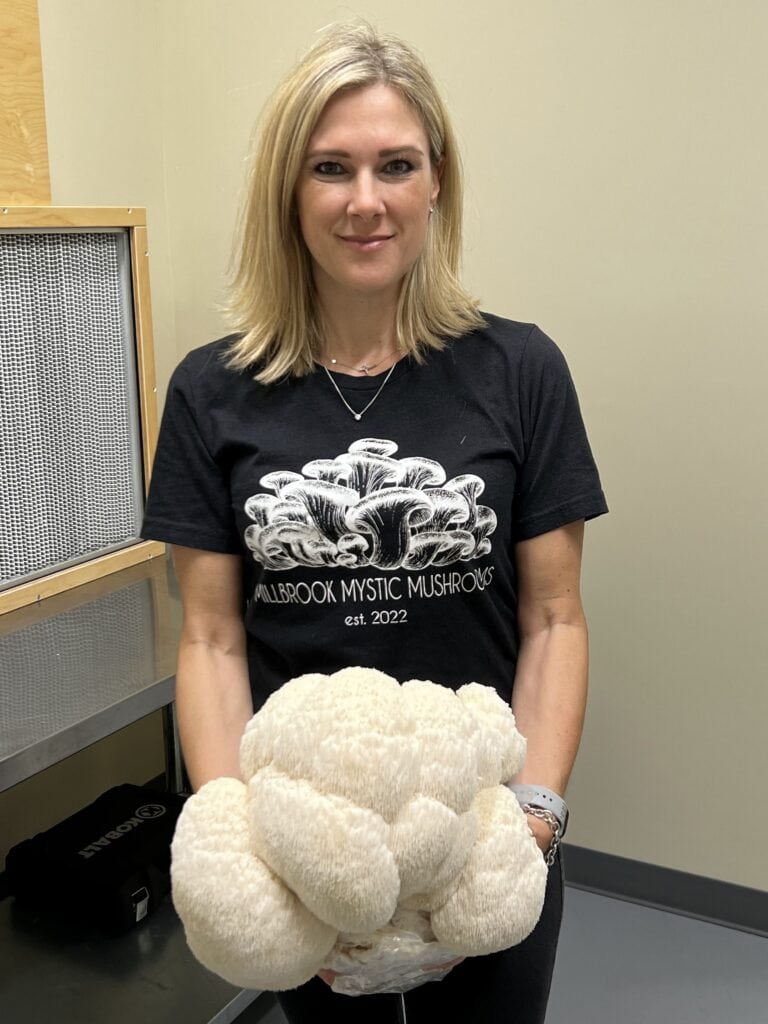
Our fruiting room is also separate and has to have a certain amount of humidity and airflow. We are the ones growing mushrooms from spore to fruit. There’s no handoff. Everything happens here at our farm. We harvest the mushrooms, put them in boxes from the US (from Colorado), and deliver them to our chefs and local food stores. We don’t hire a third-party company to do that.
Since we live on six acres, we don’t have that much space, so when we’re done harvesting, we take the compost in bags and give it to people who want to use it for their gardens for free. We also spread it in our pastures and vegetable gardens. We’re super proud that it goes back to the earth.
Navigating Early Challenges
SBS – What kind of challenges did you face in the first stages of the business, and how have you overcome them?
Keri – For anybody starting a business (and even though you’re passionate about it), it does take a leap of faith, whatever faith you have. We started an LLC in 2021 but didn’t get the home equity loan right away because we wanted to work on the business plan, research, understand profit margins, etc. A friend of ours helped us initially. She gave us some insights, but she lives in Colorado, and we live in Texas, so it’s a different market. We needed to do our research about mushroom farmers here and how much they sell their mushrooms for. We didn’t know wholesale prices because people aren’t going to share their wholesale prices with you.
Going back to some of our challenges, we had to get a home equity loan first. We were blessed to have equity in our home, but some people have to go the SBA route. If you go the SBA route, they will monitor your process every step of the way. Meanwhile, home equity is my money, and I can hire who I want and have a lot more flexibility.
We took out the home equity loan in the spring of 2022. We were paying for our loan, and it took seven months for electricity to be delivered to our building. We were reaching out constantly to the power company, but they’ve got a long list of people, so we had to wait. At that time, we didn’t have production. So, I would advise you to have some money aside to pay for your startup. When we built a building, inflation happened. We did our estimates of how much our building would be, but it ended up being nearly double by the time we were done because of the cost of materials. We didn’t finish it until June of 2023, so it was over a year before we had mushrooms in our facility on the farm. Our first mushrooms were sold in August of 2023.
We also had challenges sourcing our soy. We were paying retail prices for it. Now we have wholesale, thank goodness. If you compare our prices to a grocery store that carries our type of mushrooms, our cost is high because you pay for quality, for a small business, for a farmer doing this. Because we can now source more wholesale, we can fluctuate our prices for our chefs and consumers.
Some challenges also came with the startup, creating a website, the operation side, etc. I didn’t realize that some chefs, believe it or not, like printed invoices (and my point-of-sale system is all electronic). I learned along the way, through trial and error, about business cards and other printed things, like stickers for our boxes. We also like screen printing on our shirts, not press. I also like supporting small businesses and giving back to the community. Our t-shirts come from a local person here in Rockwall, Texas.
We’re now making tinctures (concentrated extracts of our mushrooms). We started with Lion’s Mane because it does a lot for your body. Texas has Cottage Food Law and I had to take training to become a food handler. Before I did that certification, we couldn’t be selling. These are all startup things; you have to do your research before you do anything.
By the way, I’m a list person. I have lists for my husband, like reminders of things. Also, we teach our contractors and hope to inspire them to start their businesses.
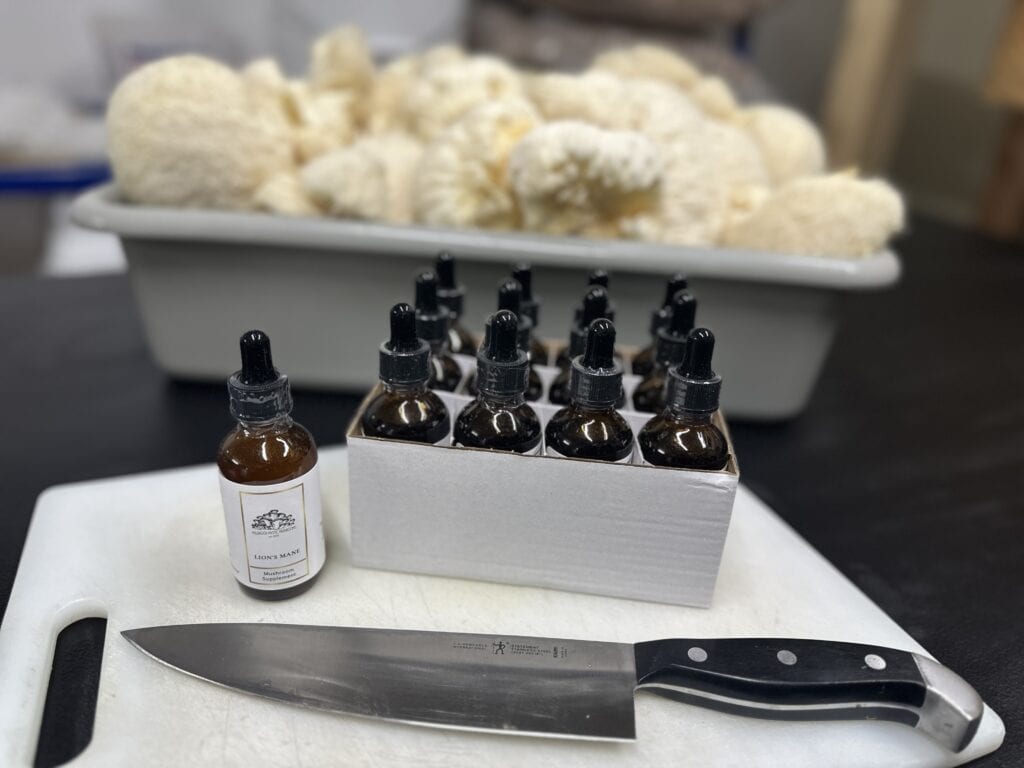
Insights into Mushroom Cultivation
SBS – Can you explain mushroom cultivation?
Keri – Some people ask us how long the growth process takes. Well, it depends on the species. For some mushrooms, it takes two to three weeks from the time we inoculate them, and some take four to six weeks.
We’re trying to grow Maitake (also known as Hen-of-the-Woods). Just to let you know, it’s very difficult to grow and it takes months. We have read and learned a lot about Maitake, and it seems we’ll probably need a different grow room for it. We are not there yet, but we’re trying to grow it.
Mushrooms grow in bags in the incubation room, as I mentioned. Our bags have a way to get rid of their CO2 (hence the CO2 monitors). When we take bags to the fruiting room, we make an X in them. Why do we do that? Because mushrooms love oxygen. When you open up the bag in a room with high humidity with those amazing lights and fresh air coming in and out, they fruit.
Then, that’s when we harvest. We wear gloves, but we also sanitize our hands before that with an alcohol spray. We take the bag with this beautiful mushroom that has fruited, and we bring it into another room that’s very cold and has specific moisture levels. We have a scale and boxes there. We put parchment paper in boxes. When we harvest the mushrooms, we go underneath them in the bag, shake them a bit, and take them out. Of course, we clean them up a bit because they might still have some oak or soy stuck. After that, it’s weighing time.
We have two different boxes — chef’s mix and retail. Chef’s mix boxes have different mushrooms that we put in there, or our chefs tell us what kind they want. Our goal is to tailor our offer to what chefs desire. We have a chef here in downtown Rockwall who fries Blue oysters, and now he’s moving over to Chestnut mushrooms because he loves them. We grow both types for him. There’s another amazing restaurant that has only our mushrooms on their menu. Every time we see our name on a menu, we pinch ourselves. We have a new chef who came on board in Dallas. She’s reached out to us about Pioppino and Chestnut mushrooms, and we said we can grow them and have them consistently for her. However, because fresh air comes in, the time of the year plays a role. We grow Snow oysters (aka Winter oysters). The reason why they’re called that is because of cold. So, what happens outside has an impact inside. Pink oysters are our spring/summer mushrooms, for example.
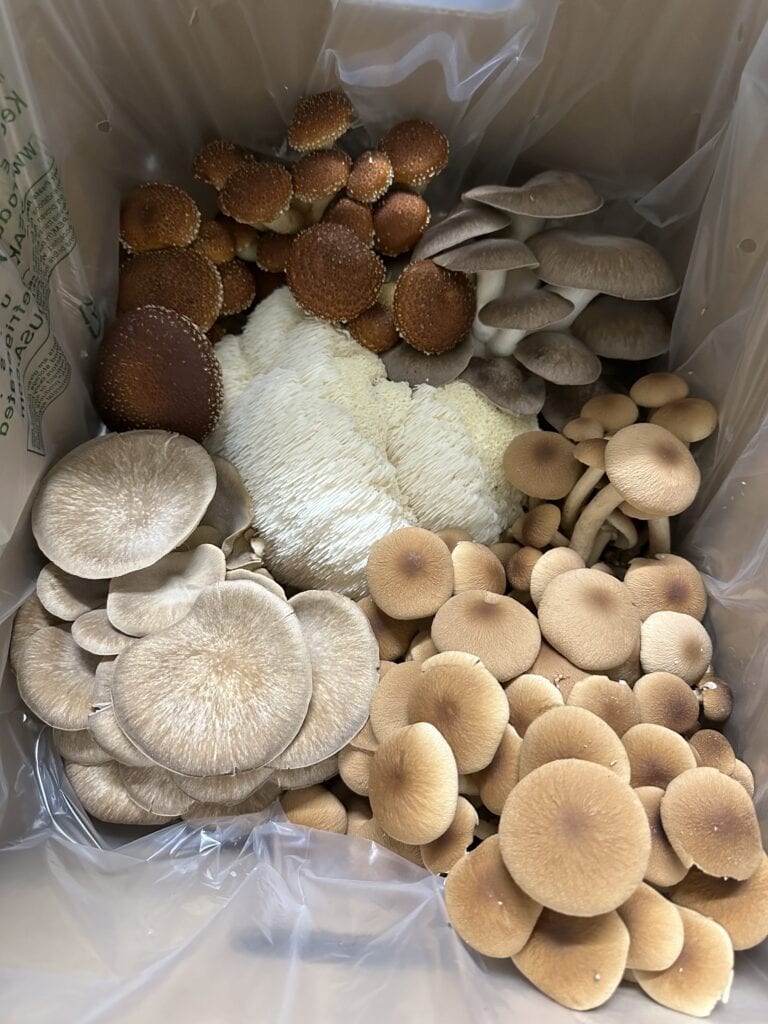
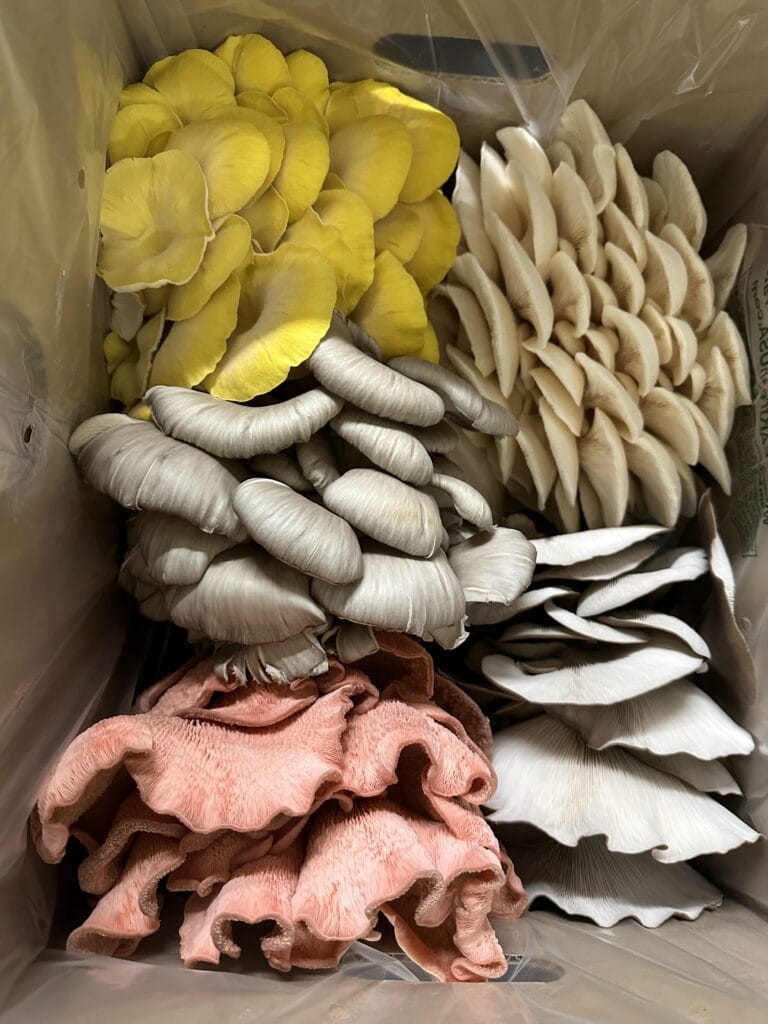
Our other box is for retail. We go to farmers’ markets, but we also have local health food stores that we sell at. We belong to a farmers’ co-op where people can order our products the first and third week of the month and pick up the second and fourth weekend. Since marketing is my lane, I thought about a bakery box with a cellophane window in the front. We love that kind of box to showcase our mushrooms because they’re beautiful, they’re vibrant, and they have gorgeous colors. When you’re at a farmer’s market or the local health food store and see the quality, it goes a long way. That said, we had to retrofit a bit because you have to have air coming in. We got a hole puncher and started punching holes in the box. No big deal! Finally, we put stickers on our boxes, and they really stand out.
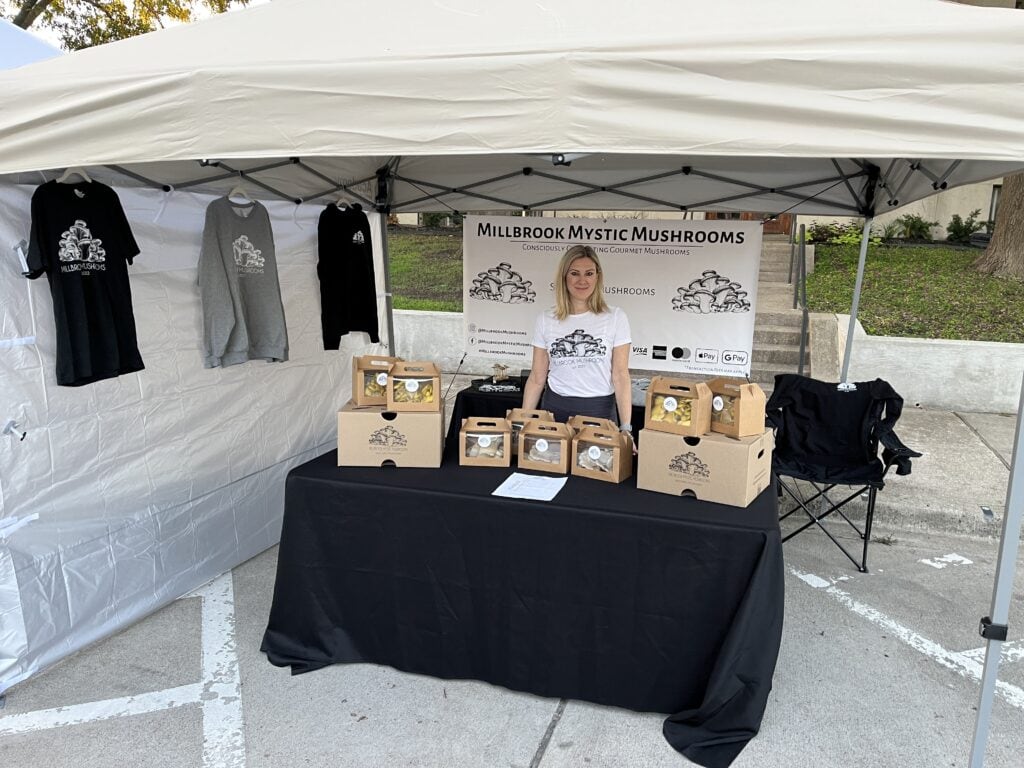
Evolution of Marketing Strategies
SBS – How did your marketing strategies change over time? How do you keep old customers and attract new ones?
Keri – Social media plays a massive role from a marketing standpoint. Here’s a couple of things that we have learned, too.
I hired somebody to help build our website because I didn’t know how. They taught me how to add mushrooms to the website and do other things. When we launched our website, it was pretty basic. It just had an introduction and locations you could find us at.
Then, I felt like we needed to showcase our mushrooms, so I came up with the Meet Your Mushrooms page. We had to describe and explain what they’re used for. We added some wellness information backed by research. You also have to put some disclaimers because some people think that mushrooms can cure everything, for example.
After that, we created recipes because people kept asking us to tell them how we cook. Creating recipes took a lot of time, work, and effort. My husband is the cook in our house, doing everything out of his head. He’s so creative! Naturally, it wasn’t easy to say how much of everything to put in a recipe, but we managed and updated our website again.
Here’s the other marketing thing we did. We emailed chefs, and some of them responded, and some of them didn’t. We learned it’s good to take your box of mushrooms to a restaurant and show up between two and three because that’s when they’re prepping for that evening. You introduce yourself and give the box for free.
You also have to support local chefs. We’re big on eating at all the different restaurants. Some people, being purveyors, think that they only need to sell the product. No, we’re supporting our chefs and our community, and they’re supporting us. We post and tag them on social media. I follow some other chefs and restaurants. I wasn’t doing that initially. Some chefs like to reach out via Instagram on Messenger, and chefs talk to other chefs, so that’s how the word about us gets out.
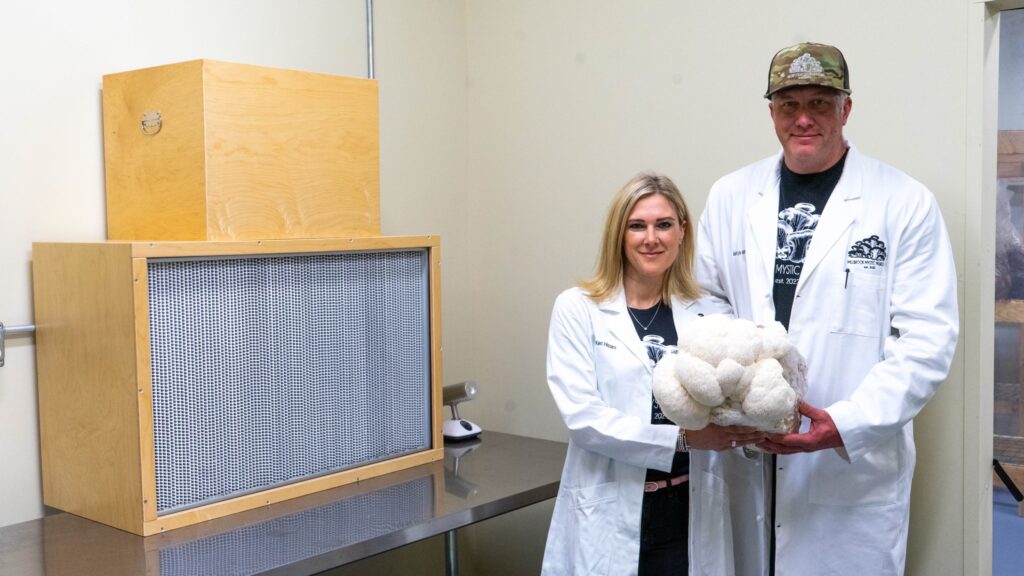
Words of Wisdom for Aspiring Mushroom Farmers
SBS – What advice would you give someone who wants to start a mushroom business?
Keri – First and foremost, make sure you have passion for it before you start anything. It’s not going to take off if you don’t have passion. My second piece of advice is to do your research. Do your homework, get to know the competition, and learn about how mushrooms grow and what’s required for it. You need to do not just market research but also research and understand how to have a mushroom farm. There are people who tour mushroom farms.
I gave an example of Maitake, which needs its own room now. There’s a way to do this without building individual rooms. A friend of ours uses climate-controlled tents.
As an entrepreneur, you will have to roll up your sleeves and learn all the different things about running a business, and it will be trial and error. You should apprentice with people and find someone to help you navigate. Ask for referrals when you’re starting, and don’t give up. It doesn’t have to be the end if someone said “no” to you once or twice. One store refused us two times, but now we’re there because of how much people have asked for us.
One last thing: You’re going to be negative financially, which is not easy. But focus on the positive. Every new restaurant and every new customer we get is optimistic. It’s got to start somewhere. If you believe in it and have passion, focus on that. Every “yes” you get is getting you to continue building your business.
Subscribe to Our Newsletter
and gain insider access to cutting-edge business insights and trends.
Featured Resources

How Kalve Makes High-End Coffee Accessible for Everyone
Published on April 3, 2025
Read Now
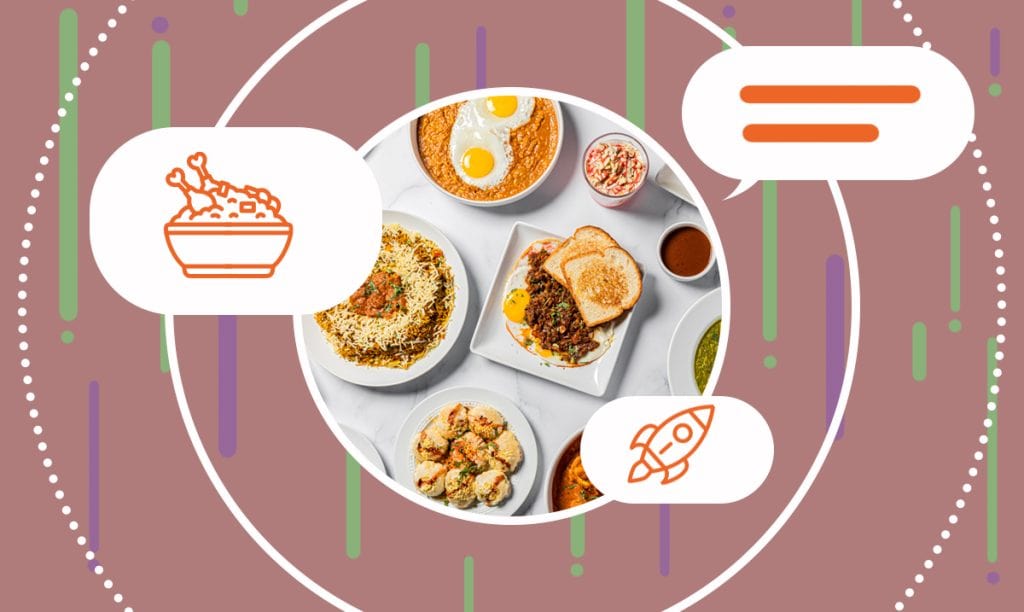
How Eggholic is Bringing Authentic Indian Street Food to the US
Published on February 25, 2025
In this interview, we speak with Bhavana Singh, the visionary behind Eggholic, a restaurant that brings the authentic flavors of Gujarat’segg- ...
Read Now

How a Historic Theater Became Houston’s Chic Bar
Published on January 2, 2025
Nestled in the heart of Houston’s Montrose neighborhood, Clarkwood is more than just a chic wine and cocktail bar— it’s a celebration ofhistor ...
Read Now
Comments